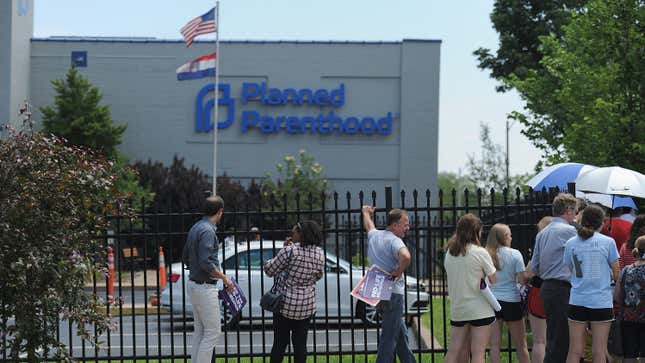The New York Times Wonders If Maybe the Left Is to Blame for Abortion Bans
Latest

Amid near-total abortion bans in a growing number of states and the rise of unscientific laws designed to punish pregnant people who do not carry fetuses to term, a recent New York Times article asks if perhaps abortion rights are eroding because pro-choice leaders grew too unfocused and complacent.
The Times report features interviews with “more than 50″ leaders in the reproductive rights movement, chronicling where the left went wrong in defending abortion rights. The consensus, according to the Times’ compilation of these interviews is that complacency during the Obama administration—during which anti-abortion politicians were able to all but stack state courts with sympathetic judges and redraw districts to favor conservatives—helped create an environment in which criminalized abortion could proliferate. While abortion might have appeared safe on the national level during Obama’s presidency, over the past decade, conservatives were able to quietly set the stage for the attack on reproductive rights at a local level. Much of the blame, according to the writers, falls on Planned Parenthood; the report takes care to highlight the financial disparities between Planned Parenthood and the struggling abortion providers in states where access to abortion has been curtailed by political pressure:
“This past summer, for instance, after Alabama passed its near-total abortion ban, celebrities and liberal donors opened their checkbooks en masse to support Planned Parenthood. The founder of Tumblr gave $1 million. The pop star Ariana Grande held a benefit concert.
At the same time, Gloria Gray, who heads the West Alabama Women’s Center in Tuscaloosa, said she couldn’t afford to give her staff raises or pay for a $20,000 fence to keep the daily protesters off the property. Her crowdfunding effort produced about $4,000.”
According to the Times, responsibility for providing abortions disproportionately falls on these smaller, underfunded clinics in states like Alabama, where Planned Parenthood performed no abortions last year. An interview with acting Planned Parenthood president Alexis McGill Johnson seemed to confirm the overall stance of the piece, which seems to be that national pro-choice groups are too focused on lobbying power at the expense of providing actual abortions:
“A lot of us are awakening to the fact that if you are wealthy, if you live in the New York ZIP code or California ZIP code or Illinois ZIP code, your ability to access reproductive health care is not in jeopardy in the same way that it is in other states,” McGill Johnson told the Times.
But on Twitter, McGill Johnson said her words—which, in another context read as a pretty standard fact about abortion access— were taken out of context and insisted Planned Parenthood continues to “[ring] the alarm bells about different access to care while building power statehouse-by-statehouse to fight for equity.” Contrary to the Times portrayal of Planned Parenthood as a national silo draining money from small providers with no political power, McGill Johnson says the nonprofit organization “is part of a broad and diverse family that includes independent providers, reproductive justice groups, and local abortion networks who are working together to ensure that all people have the right AND the ability to access the care needed to control their own bodies.”
In the thread, McGill Johnson cites “huge electoral wins” by Planned Parenthood in recent elections, though those wins perhaps wouldn’t have been necessary had the right been prevented from gerrymandering districts and passing small restrictions in conservative states that ultimately amounted to the sweeping abortion bans threatening the country today.
Overall, there seems to be no clear consensus on where the left went wrong in the battle for abortion access. Leaders either “overly prioritized politics and power” or they allowed power to erode during the Obama presidency. They either focused too much on demanding support for abortion rights from Democratic candidates or they lost focus on providing abortions by focusing on broader women’s health issues. The report concludes with a longtime abortion rights activist longing for the grass-roots movement of previous generations, but the piece fails to address how that is possible without a focus on messaging, lobbying, and challenging present-day laws.
And the Times report fails to mention the lawmakers—both Democrat and Republican—who allowed an insistent minority to shape public policy, advocating draconian abortion laws despite the 77 percent of Americans believe Roe v. Wade should be upheld. Instead of assigning blame to activists for losing the battle, it might have been more helpful to examine how, despite the existence of organizations like Planned Parenthood, we got to a point in which lawmakers in Ohio are seriously considering a bill requiring doctors to re-implant ectopic pregnancies—a feat that is not just unproven, but medically impossible. It’s not just because Planned Parenthood was asleep on the job.
Missing from the discussion is the history of how the right built up the momentum to erode those rights in the first place. Examining the failures of the left without also digging into the strategies of the right effectively scrutinizes the defense without talking about specific battles—with only vague references to any sort of broader war. It’s trying to understand D-Day without mentioning Normandy or WWII. Such an incomplete history may be full of people to blame, but it won’t provide any answers to how it came about, or how to maneuver to a different future.